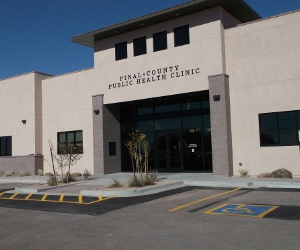
Pinal County Public Health Clinic in Maricopa. Photo by Tim Howsare.
Increasing infectious disease threats mean health departments face increasing resource constraints. To see how local health departments are managing different pressures, NACCHO Policy Scholar, Pooja Kothari, spoke with Kore Redden, the Public Health Emergency Preparedness and Response Administrator for Pinal County Public Health Services District (AZ). Redden discusses how Pinal County is coordinating its preparedness and response efforts with those of first responder agencies.
Thank you for taking the time to talk with us about your preparedness efforts. Can you give us an overview of how your health department addressed Ebola-related questions from the public and from first responders?
We received very few calls from the general public about Ebola, most of our inquiries were from first responders. We hold meetings on a regular basis with the law and fire associations to keep them informed about any information we have and to address their questions. The state sent out letters to all the licensed facilities and copied the counties on the communications so that the county can then reach out and talk to the partners about specific issues. Some partners requested training and educational outreach while others requested county health department participation in their tabletop exercises.
Did you use a [United Way 2-1-1] call center to address the Ebola outbreak?
We have two call centers in the county, one which is part of a public health center and [which] receives calls for appointments for the health clinics; and the other is a county-wide call center for various public questions related to elections, public health, road closures, etc. We had scripts prepared so that if a call about a potential Ebola case or questions about Ebola were received, it would be directed to the appropriate people.
Has there been a triage system in place for the use of police and first responders based on the calls received?
We had a triage system set-up with the law and fire agency partners. Also, the state had conducted outreach with the public safety answering points (PSAPs) and 9-11 Centers, which fall under the jurisdiction of law enforcement agencies.
Did your public health department deal with resource constraints, especially with personal protective equipment?
The state sent surveys to fire and EMS agencies to inquire about personal protective equipment (PPE) resource constraints. Agencies are responsible for funding their own PPE capacity, however, if there is an emergency, as was the case with H1N1 then there could be measures in place based on direction and provisions from the Centers for Disease Control and Prevention.
Given the start of flu season, there is a push to encourage Influenza vaccinations. How has your health department addressed this, given other emergencies?
We always stress the importance of getting the influenza vaccine annually and we continue to do so at the association meetings we attend. Our health official actually coupled our Ebola and Influenza outreach message to encourage vaccination for influenza and to provide information about Ebola. We have seen an increase in the public receiving influenza vaccines this year but there is no conclusive information as to whether our messaging encouraged more people to obtain the vaccine.
Do you have any recommendations you would like to share about addressing public health emergencies when facing resource constraints?
Generally, if we are facing resource constraints then so are most agencies. We know that, in the case of influenza, there are pharmacies providing vaccines that we can encourage the public to go to if we are faced with a shortage.
How is your health department managing resource constraints in the face of Ebola and other outbreaks? Please let us know in the comments section.
Pooja J. Kothari, RN, is a Local Public Health Policy & Practice Scholar at NACCHO and a Master in Public Health candidate at the Johns Hopkins Bloomberg School of Public Health.









